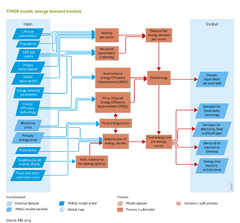Energy demand/Description: Difference between revisions
Jump to navigation
Jump to search
No edit summary |
m (Text replace - "|Status=Publishable" to "") |
||
| Line 1: | Line 1: | ||
{{ComponentDescriptionTemplate | {{ComponentDescriptionTemplate | ||
|Reference=De Vries et al., 2001; Richels et al., 2004; Van Ruijven et al., 2013; Van Ruijven et al., 2011; Isaac and van Vuuren, 2009; Daioglou et al. (unpublished); | |Reference=De Vries et al., 2001; Richels et al., 2004; Van Ruijven et al., 2013; Van Ruijven et al., 2011; Isaac and van Vuuren, 2009; Daioglou et al. (unpublished); | ||
|Description=The energy demand model has aggregated formulations for some sectors and more detailed ones for others. First, a description of the generic model is provided, which is used for the service sector, part of the industrial sector (light) and in the category ‘other sectors’. Subsequently, discuss the more specific technology-rich descriptions of residential energy use, heavy industry and transport are discussed – indicating how the description in these models relates to elements of the generic model. | |Description=The energy demand model has aggregated formulations for some sectors and more detailed ones for others. First, a description of the generic model is provided, which is used for the service sector, part of the industrial sector (light) and in the category ‘other sectors’. Subsequently, discuss the more specific technology-rich descriptions of residential energy use, heavy industry and transport are discussed – indicating how the description in these models relates to elements of the generic model. | ||
Revision as of 11:14, 7 January 2014
Parts of Energy demand/Description
| Component is implemented in: |
|
| Related IMAGE components |
| Projects/Applications |
| Key publications |
| References |
